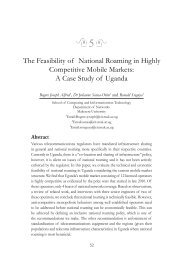John Matovu Aminah Zawedde Das Pamela and Herbert Ruhunde.pdf
John Matovu Aminah Zawedde Das Pamela and Herbert Ruhunde.pdf
John Matovu Aminah Zawedde Das Pamela and Herbert Ruhunde.pdf
Create successful ePaper yourself
Turn your PDF publications into a flip-book with our unique Google optimized e-Paper software.
62 Strengthening the Role of ICT in Development Volume VIII<br />
revenue, is threatening the fi nancial well-being -- even the very existence -- of many<br />
newspapers, including some of the oldest established <strong>and</strong> respected among them.<br />
Sparks [2006] argues that this trend is not yet being fully felt here in Africa<br />
where the business side of the Internet has not yet taken off as fully as it has in<br />
the developed world. But the migration of readers is already happening, <strong>and</strong> some<br />
early consequences are already being felt.<br />
One of the solutions according to [Sparks 2006] is to diversify, diversify, into<br />
the profi table new electronic sectors of the media, into television <strong>and</strong> cellphones<br />
<strong>and</strong> the Internet, in order to support the print media <strong>and</strong> maintain their editorial<br />
quality which is vital for their long-term survival <strong>and</strong> the democratic role they<br />
need to play.<br />
The hotly debated emergence of multimedia newsrooms [Stone <strong>and</strong> Bierhoff,<br />
2002; Deuze 2004] or pro-active diversity awareness policies [Campbell, 1998;<br />
Bealor Hines 2001; Rich, 2005] in media organizations can be seen as good<br />
examples of changes <strong>and</strong> challenges in journalistic practice. Our argument is based<br />
on the assumption that the global picture of journalism is constantly <strong>and</strong> perhaps<br />
exponentially changing to such an extent that one has to analyze <strong>and</strong> discuss the<br />
main attributes of such (potential) changes in order to successfully study, describe<br />
<strong>and</strong> explain contemporary journalism.<br />
Over the past decade or so, fundamental changes have taken place <strong>and</strong> continue<br />
to take place in broadcast media houses.<br />
Looking at it critically, the news output of many broadcasters has exp<strong>and</strong>ed<br />
rapidly since the early 1990s, <strong>and</strong> covers a wide range of media platforms from<br />
television <strong>and</strong> radio to tele-text, web <strong>and</strong> mobile phones. Subsequently, broadcasters<br />
have undergone changes in the organization <strong>and</strong> practices of production. This<br />
is perhaps most evident with regard to production for multiple platforms in an<br />
integrated media organization.<br />
To various degrees production for television <strong>and</strong> radio has been integrated with<br />
production for digital media. Radio <strong>and</strong> television reporters who used to exist in<br />
separate worlds, are now working together, cooperating across media boundaries.<br />
The number of reporters who are able to work for both television <strong>and</strong> radio is<br />
increasing. The platforms of radio <strong>and</strong> television have been converging in terms<br />
of production processes, <strong>and</strong> later web <strong>and</strong> other platforms such as mobile phones<br />
have been added [Erdal 2007]. In the wake of all these developments, specifi c<br />
research issues arise. Related to changing professional practices, questions for<br />
example of how reporters relate to their editors need to be answered. How is<br />
production for multiple media platforms conceptualized within the organization?<br />
How are news items made for <strong>and</strong> published across different media platforms?<br />
Critics in Ug<strong>and</strong>a have commented on the declining quality of journalism<br />
manifested in increased factual <strong>and</strong> other errors as well as in the choice <strong>and</strong><br />
placement of content. Increased commercialization of media houses <strong>and</strong> the<br />
struggle to meet bottom lines has led to the downsizing of editorial departments<br />
compromising the traditional stringent gate-keeping processes.
















